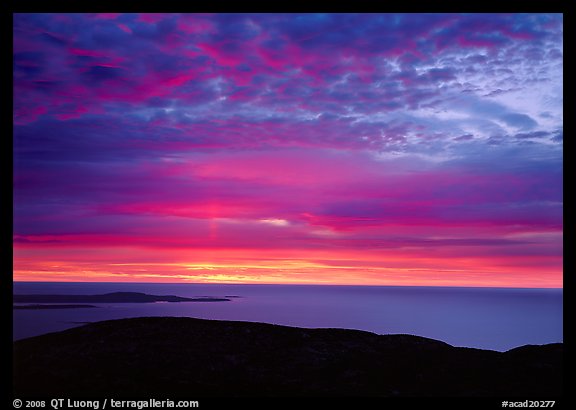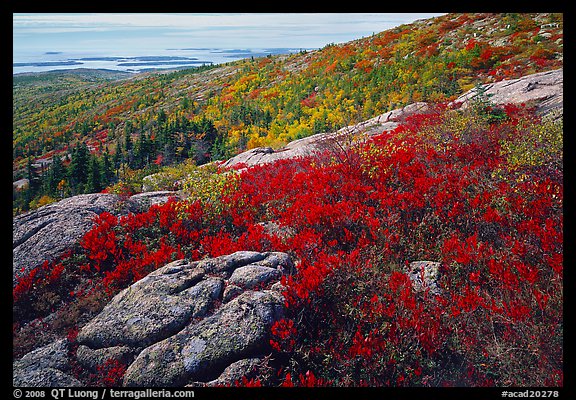Photo Spot 31: Acadia National Park – Cadillac Mountain
No Comments
Acadia National Park is my favorite landscape location on the East Coast because it packs in a small area (only 40,000 acres) such a great variety of scenery. The shoreline includes beaches, headlands, boulders, and slabs with a range of orientations. Large and small freshwater bodies are surrounded by two major forest types (eastern deciduous and coniferous north woods) meet. Then, there are the peaks, both forested and bald, from which you can see all those landscape elements at the same time.
The grandest of those peaks, Cadillac Mountain, is also the most accessible, as it is reached by car though a short 3.5 mile road. Despite its modest 1,530 feet elevation (which makes it technically only a hill, because short of 2500 feet), Cadillac Mountain is the highest point on the east coast of the Americas from the Arctic to Rio de Janeiro.
The island on which Cadillac Mountain rises was called Mount Desert Island by early explorers because of the baldness of the peaks. Most of the vegetation consists of berry plants. The trees growing on the top, stunted and twisted like bonsai, will not hamper your views over the ocean and Frenchman’s Bay, as well as over the park forests. Both sunrise and sunset can provide great light.
Because of its eastern position and elevation, the first sun rays to strike the continent are seen from Cadillac Mountain. This is a popular sight. I was surprised to see the parking lot half full at 5.30am, and visitors spreading out on the granite slabs with blankets. For more varied views and less people, you can always hike a short trail around the summit, or down the 3-mile South Ridge trail to Blackwoods Campground.
On my last visit to Cadillac Mountain, the summit was shrouded in heavy fog. I saw some stepping out of their car, declaring that there was nothing to see, and quickly getting back to the car. But actually, even on a foggy day, there is plenty to see. The vegetation (especially in autumn), pink granite, and colorful lichen, provide for interesting close subjects, which also make for great foregrounds on clear days.
Spring is nice and quiet. Summer visitation can be overwhelming, as the park receives 2 million visitors in the year, certainly because it is the only National Park in New England, within a day’s drive for more than 50 million people. Yellowstone may get 3 million visitors in the year, but at over 2 million acres it has 50 times the surface area to absorb them. For quieter alternatives to Mount Desert Island, check my two other blog posts of this week. Autumn arrives in October, and in general peaks in the middle of the month, later than the rest of New England. This is the best time to be there, as exquisite color is present through the park, not only on the trees, but also on the ground, thanks to the berry plants. Like most of park roads, Cadillac Mountain closes in winter.



View all images of Acadia National Park

